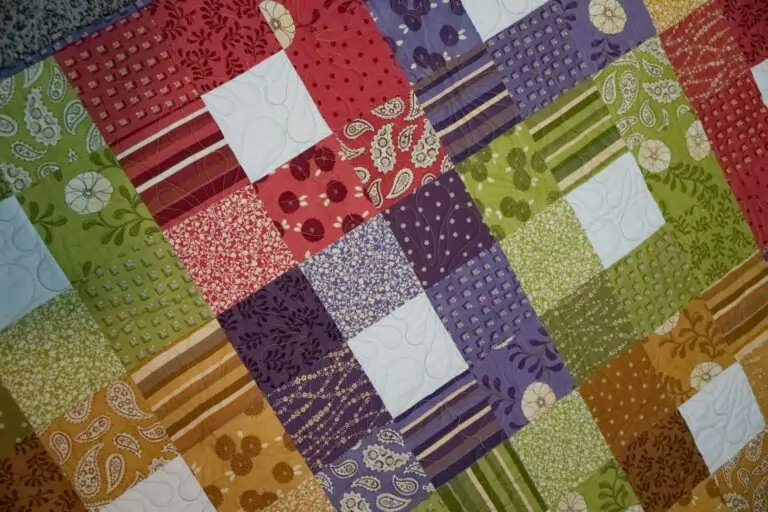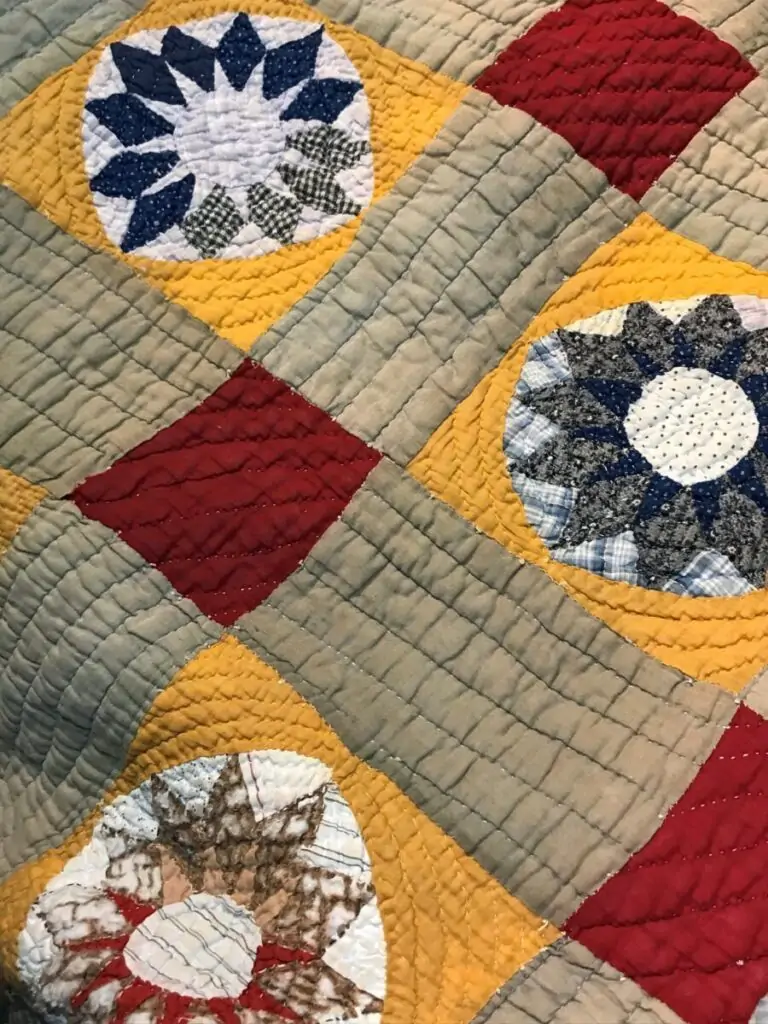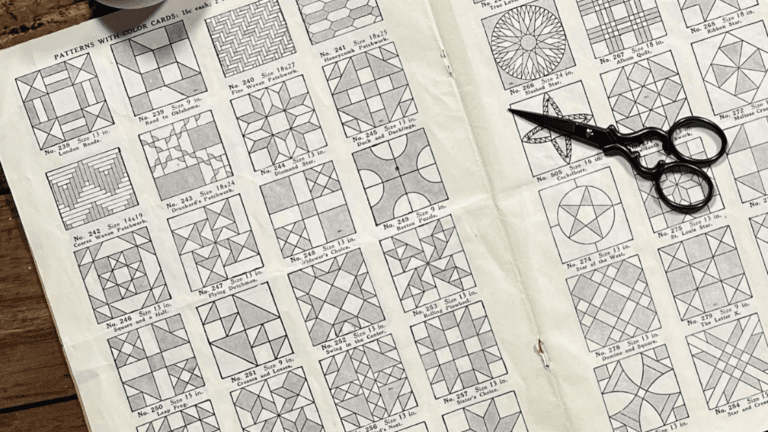How to Sew the Nine-Patch Quilt Block
- How to Sew the Nine-Patch Quilt Block
- Perfect Flying Geese Blocks Every Time
- the Vintage Snowball Quilt Block: Simple But Stunning

The vintage Nine-Patch quilt block, is simply nine squares of fabric sewn into a 3 x 3 grid. The layout of light and dark fabrics shown below is probably the most recognized layout for the block. However, any combination of nine fabrics assembled in a 3 x 3 grid is a Nine-Patch block. There are several examples of Nine-Patch blocks later in this post that show its versatility.
Additionally, the use of nine equal squares makes it easy to make a finished block of any size. The block can be as large or as tiny as you desire. It only requires a little math.

In this post, we will cover a bit of history, an easy technique to create the block using strips of fabric, and the best pre-cuts to use if you don’t like cutting yardage.
First a Little History
One of the oldest known quilt blocks is a Nine Patch block. In fact, it appeared in publication as early as 1896 in The Ohio Farmer according to The Encyclopedia of Pieced Quilt Patterns by Barbara Brackman. It has been a popular choice with quilters for well over 125 years due to its simplicity.
Young girls often learned to sew by making this simple block. It was an economical choice for beginners since only scraps of fabric were needed. In fact, it is still the perfect block if you’re a beginner or if you just want to step back and hone your sewing skills a bit. It is arguably the best block on which to practice sewing straight 1/4-inch seams either by hand or on a sewing machine. It is also great for mastering your skills at nesting seams.
Simple but Not Boring
Don’t let this little block fool you! It might be simple and easy enough for the beginner, but it is also adorable when used in a quilt top. The basic layout shown above yields a quilt top with a crisp, clean feel. Use a jelly roll to make a color-coordinated quilt top that is more scrappy. Likewise, combine the Nine Patch quilt block with a Snowball block and you get a stunning quilt top that resembles a lattice.
You can make this block using fabric scraps, yardage, or pre-cuts. The Nine-Patch is a very versatile block and every new quilter should master it.
The Nine-Patch Quilt Block Layout
While the name ‘Nine Patch’ refers to a block with nine patches of fabric, it also refers to the actual block layout. In other words, the patches need not be just squares of fabric. Quilters often combine different quilt blocks in a 3 x 3 grid and refer to it as a ‘nine-patch’. In fact, you’ll see examples later in this post of a variety of ‘nine-patch’ blocks.
Most of the examples are equal Nine Patch blocks. However, not all Nine Patch quilt blocks have units that are equal in size. While sewing equal fabric patches together is probably the most common technique, there are many patterns for unequal Nine-Patch blocks as well.
Master the assembly of this block and you will have the skills to make any nine-patch block.
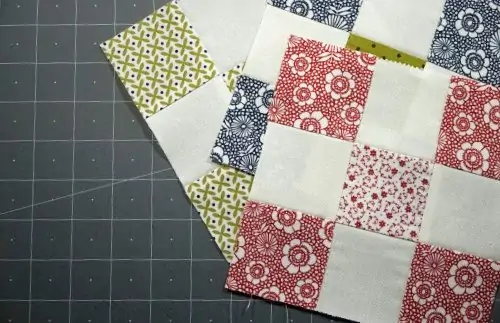
Quilt Math for the Equal Nine-Patch Quilt Block
So, let’s talk about constructing a basic equal Nine-Patch block. You must first decide the size of the finished block you want to make. Keep in mind that because there are 3 equal horizontal rows and 3 equal vertical rows choosing a size divisible by 3 will make the math easier.
I prefer a 6-inch finished block. It looks neat and tidy, but the squares are not so tiny that I have trouble sewing a straight 1/4-inch seam on my sewing machine. So, that being said, let’s do the math for a 6-inch Nine Patch.
Math for a 6-inch Nine-Patch Quilt Block
I want a 6-inch block when I’m finished sewing the quilt. In other words, if I measure the blocks once the entire quilt top is constructed, each of them will measure approximately 6 inches square. So, divide 6 by 3 to determine that each patch in the Nine Patch should measure 2 inches square when finished.
But wait, don’t start cutting yet! You must include a seam allowance or you are going to be very disappointed with your finished block. Since I will sew a 1/4-inch seam on every side of every square, I need to cut my fabric squares to measure 2 inches + 1/2 inch (to account for the seams). So, I will need 9 squares of fabric that measure 2-1/2 X 2-1/2 inches.
(Finished Block Size / 3) + 1/2" = Size to cut each patch
Math for Common Nine-Patch Block sizes
6″ finished block/3 = 2 plus 1/2″ = 2 1/2″ patches
9″ finished block/3 = 3 plus 1/2″ = 3 1/2″ patches
12″ finished block/3 = 4 plus 1/2″ = 4 1/2″ patches
How to Make a Nine-Patch Quilt Block Using Fabric Strips
While you can certainly cut your fabric into 2 1/2″ squares and sew them together, I prefer to sew before cutting.
Using strips of fabric is a more efficient way to make a Nine-Patch. Fat quarters, yardage, and jelly rolls work well for this method. For instance, fat quarters and yardage can be cut into strips of any width to create different Nine Patch quilt block sizes (see measurements above for patches). On the other hand, using a jelly roll is a quick and easy method to create 6-inch Nine Patch blocks.
The example below uses two fat quarters and can make as many as 10 Nine-Patch blocks.
Instructions

Total Time: 40 minutes
-
Choose two contrasting Fat Quarters (1 light and 1 dark)
-
Fold each fat quarter (FQ) into a 10″ X 18″ rectangle. Trim to straighten the 10″ sides of each Fat Quarter. Align your ruler with the straightened 10″ side. Measure and cut [6] 2-1/2″ X 20″ strips.

-
Unfold each strip and lay them out with light and dark fabrics alternating as shown below. You should have two of each light/dark fabric combination.


-
Sew the strip units together Right Sides Together (RST) on the long edges. Press seams toward the dark fabric.
-
Sub-cut each strip unit into 2-1/2 inch units that look like the ones pictured below. (You should be able to cut approximately 8 units from each strip set)
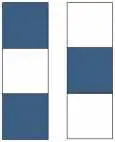
-
Arrange the sub-cut units as shown, nest seams, and sew together to create Nine Patch Blocks. Press seams to one side. Square each block to 6 1/2-inches.

-
You should be able to make 10 Nine Patch Blocks by combining the sub-cut units into the layouts shown in step 6. You will have leftover sub-cut units. Save those leftovers and if you choose to make a quilt, you can add them to the top and bottom of the layout to add a little length.
Supply:
- 2 Fat Quarters (1 light/1 dark)
Tools:
- Quilt ruler
- Rotary cutter
- Thread
- Needle for hand-sewing or sewing machine
Nine-Patch Blocks Within a Nine-Patch
While you can make a lovely quilt block with nothing but nine squares of fabric, there are many other quilt blocks that use a Nine Patch block in a Nine Patch layout. Once you master the simple Nine Patch Block, try creating one of the vintage block patterns below.
Equal Nine-Patch Quilt Blocks
Below are a few examples of Equal Nine Patch blocks, so named because each of the nine units in the block is the same size. Notice that the units shown in the blocks below range from simple squares and rectangles to Flying Geese and Half Square Triangles (HST).
However, all the blocks are constructed using the usual nine-patch method. Believe it or not, your seams will match more accurately if you assemble these as nine-patches rather than sewing individual pieces of fabric together by in row.


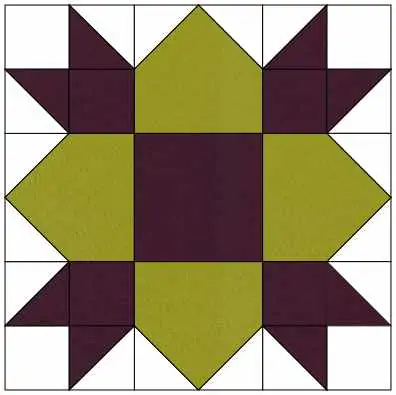
Unequal Nine-Patch Quilt Blocks
But wait, that’s not the end of the story for the humble Nine-Patch block. Not all Nine-Patch blocks have equal units. The examples below are made of 4 equal units, but note the smaller strips of fabric set between the equal units. Since the strips are more narrow, it makes the block unequal, but all are still assembled like a nine patch.



Best Pre-Cuts to Use for the Nine-Patch Block
If you love using pre-cuts, the Nine Patch Block might be just the block to make. Obviously, it is easy to make with fat quarters as outlined above. Actually, all of the standard fabric pre-cuts are easy to use when making Nine Patch blocks.
Fat Quarters: Cut into any size strip using the math and directions above.
Jelly rolls: Perfect for a 6-inch finished Nine Patch Block.
Charm Squares/Layer Cakes/Mini-Charms: And, of course, you can always make a Nine Patch Block by simply sewing squares of fabric together which makes it the perfect choice for Charm packs, Layer Cakes, and Mini-Charm packs.
See our Savannah Charms Quilt blog post for an example of a quilt made with charm packs.
So many Options
There are so many options for Nine-Patch blocks that you could easily make hundreds of quilts using nothing but this versatile block! Color arrangement and size would change the look of every Nine-Patch quilt.
Get creative with your color choices and placement and make an easy Nine-Patch quilt!





